Observation and analysis of SAO76103 in Sep. 10, and Dec1. 2009 (UTC)
Oct. 24, 2009
reviced Jan. 11, 2010
Kazuhisa Miyashita
in Japanese
Doublestar Report to IOTA coordinator
Two occultation events of this star were observed in Sep. 10, 2009. And in the other oppotunity, Dec. 1, Karasaki-san who also observed
this star in Sep. 10 observed it again. From this, an astrometric analysis become to be possible.
Observation details
September 10, 2009 December 1, 2009
H. Karasaki M. Ishida H. Karasaki
Star Mag = 7.93 Star Mag = 7.93 Star Mag = 7.93
Event = R D Event = R D Event = D D
PA = 240.950 PA = 242.860 PA = 84.320
AA = 254.501 AA = 256.410 AA = 98.141
l = -4.430 l = -4.409 l = -4.309
b = -5.183 b = -5.175 b = -5.096
RV = 0.5282 RV = 0.5425 RV = 0.4098
CCT = -170.60 CCT = -172.30 CCT = -13.50
T1 = 54.75 T1 = 52.49 T1 = 50.20
T2-T1 = -0.05 T2-T1 = -0.07 T2-T1 = -0.07
|
|---|
Occultation timing report
Place name Nerima, Tokyo, Japan
Email address
Representative Hideyoshi Karasaki
TB CED 20 146 +13940xx.x +3544xx.x 84 xx M
TC CED 20 454 +1394001.2 +3544xx.x 84 xx M
OA H. Karasaki
20090910140854.70 X 4786 RD EG G0.02 1 W 222 BA
20090910140854.75 X 4786ARD EG G0.02 1 E 222 BA

20091201120750.27 X 4786 DD EG G0.04 1 W 31 CA
20091201120750.34 X 4786 DD EG G0.02 1 E 31 CA
-------------------------------------------------------------
Place name Matusaka, Mie, Japan
Email address
Representative Masayuki Ishida
TA NED 16 100 +13628xx.x +3435xx.x 84 xx M
OA M. Ishida
20090910140652.41 S 76103 RD EG G0.04 1 W 11 AA
20090910140652.48 S 76103 RD EG G0.04 1 E 11 AA
|
|---|
Light curve and Explanation
i) Karasaki's observation (Sep. 10, 2009)
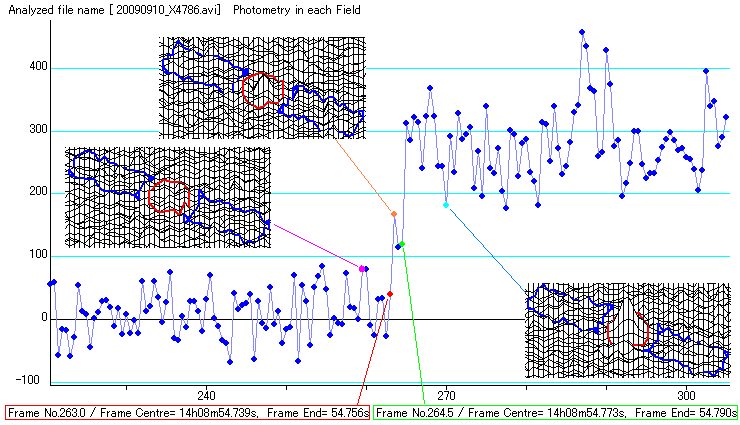
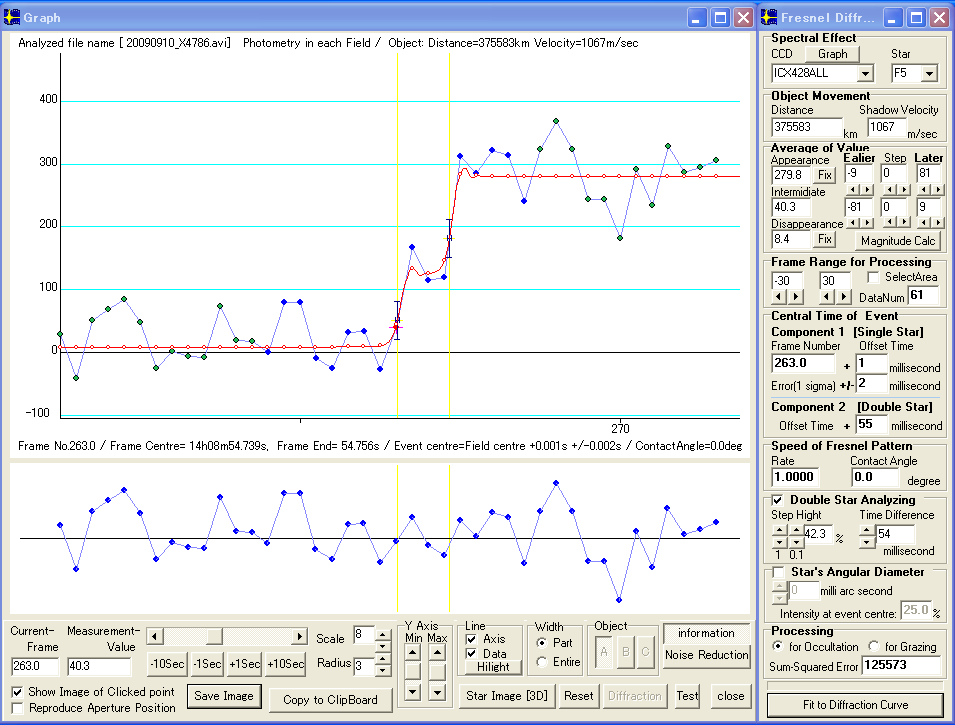
Karasaki-san (Mr. Hideyoshi Karasaki) observed xz4786, and he found a small step on the lightcurve.
As a result of my confirmation analysis, the 3D graoh at the intermediate value shows the appearance of a faint star,
and the diffraction simulation indicates that the event could not make gradual light change.
From this, it is thought that the step is generated by a double star which consists of two similar magnitude stars.
ii) Ishida's observation
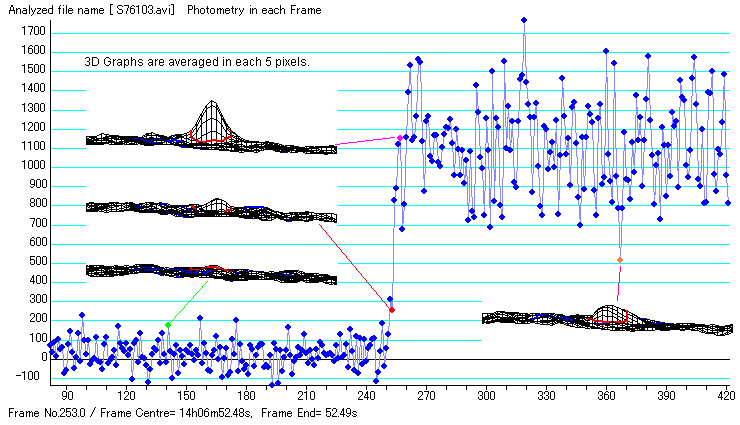
Ishida-san (Mr. Masayuki Ishida) also observed SAO76103 occultation and sent me his video file.
The video is noisy, so I used small (4 pixel radius) aperture to reduce the background noise, and I obtained Limovie graph.
There is a small step at No.252 and 253 frame. It is also confirmed from the image of a faint star on the 3D-graph of 252 (253) frame.
Additionally, the RV is 0.5425, therefore it is difficult to think that the step is generated from diffraction tail with noise.
Although the step height is different from Karasaki-san's observation, I think the light curve (and 3D graph) indicates that there is a component of closed double.
 iii) Karasaki's observation (Dec. 1, 2009)
iii) Karasaki's observation (Dec. 1, 2009)
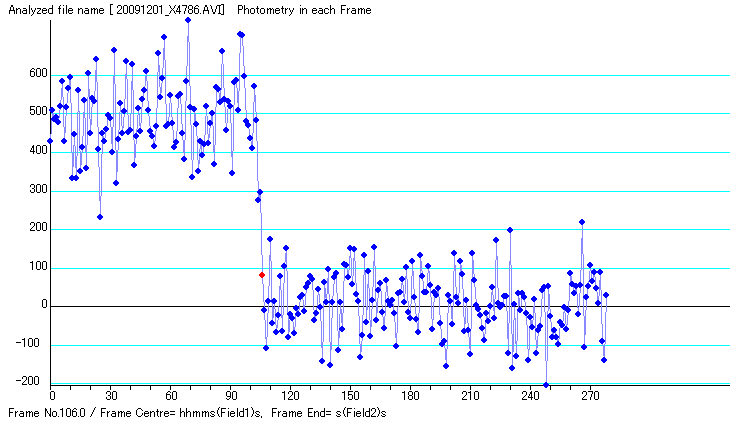
Karasaki-san, who is one of the observer of above occultation event,
had observed same star again and found small step on the light curve.
I also analyzed his video with Gaussian noise reduction filtre and
confirmed the step. I think this step like light change is not a
diffraction tail.
Photometry
i) Karasaki's observation (Sep. 10, 2009)
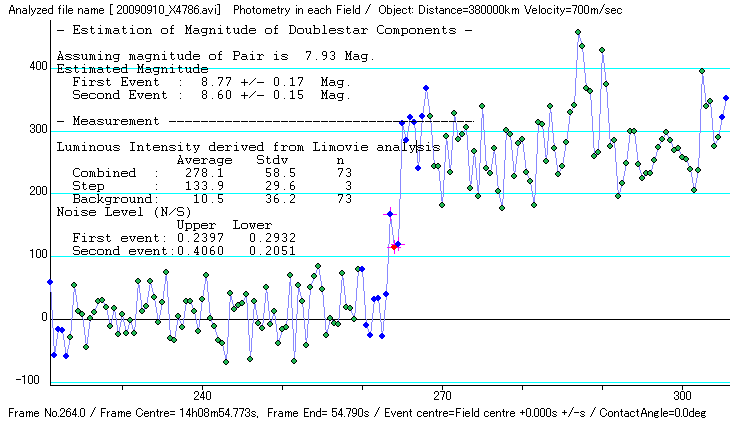
ii) Ishida's observation
- Estimation of Magnitude of Doublestar Components -
Assuming magnitude of Pair is 7.93 Mag.
Estimated Magnitude
First Event : 9.49 +/- 0.13 Mag.
Second Event : 8.22 +/- 0.05 Mag.
- Measurement ---------------------------------------
Luminous Intensity derived from Limovie analysis
Average Stdv n
Combined : 1110.1 235.5 120
Step : 280.7 40.6 2
Background: 22.2 68.3 120
Noise Level (N/S)
Upper Lower
First event: 0.1570 0.2643
Second event:0.2839 0.0489
|
|---|
i) Karasaki's observation (Dec. 1, 2009)

From IOTA coordinator
[Jan. 10, 2010]
Thank you for the report of the observation of S76103 by Karasaki-san.
With his earlier observation and the one by Ishida-san on September 10
it is possible to get a solution for the position angle and separation of the pair:
PA = 163.0±2.6° separation = 0.139±.026".
I have attached the solution as generated by Occult.
The two magnitude determination by Karasaki-san also match well: 8.60+8.77 in September and 8.60+8.78 for this observation. It is strange that the magnitudes by Ishida-san appear so different: 8.23+9.48.
Brian
IOTA coodinator's astrometry
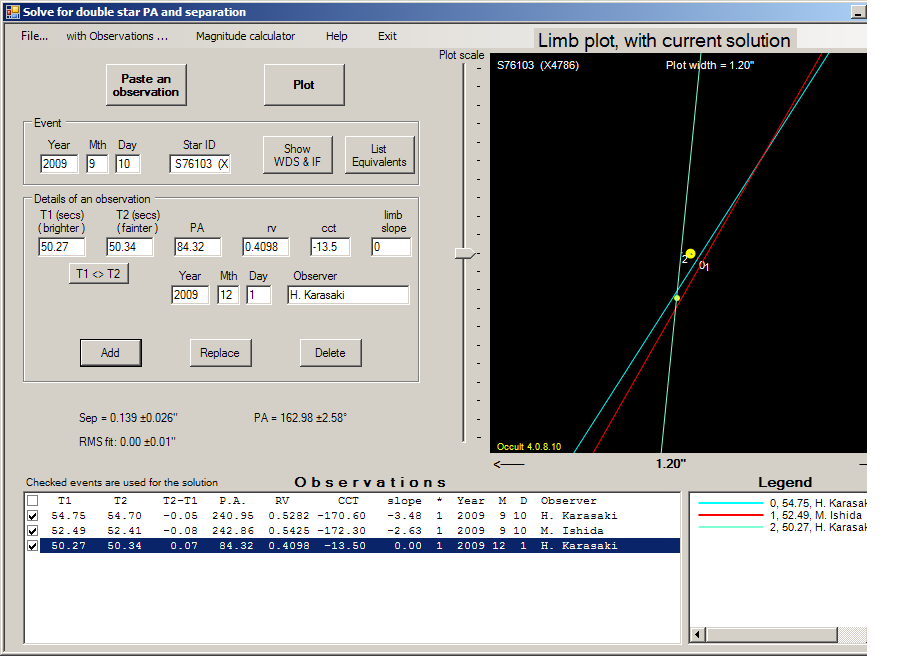
[Sep. 14, 2009]
Hello,
Thanks for the two reports on the occultation of S76103. My thanks also to Karasaki-san.
While both look to suggest the observation of a double, the difference in magnitude steps does raise problems.
Further observations would be very useful.
The two observers are too close in event PA for a useful determination of the separationa dnPA of the pair.
However it looks as if they are closer than the extrapolated 0.9" separation which suggests a 1.7 second time difference.
There are 2 opportunities for Japan, 2009 Dec 1 and 2010 Jan 25. Also 2009 Nov 4 for SE USA, 2009 Dec 28 Europe.
During 2010 the occultations move south, but are poorly placed. 2011 Jan 15 may be possible from Australia, after which they cease.
Brian







